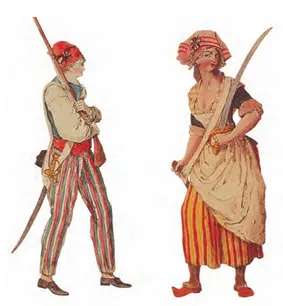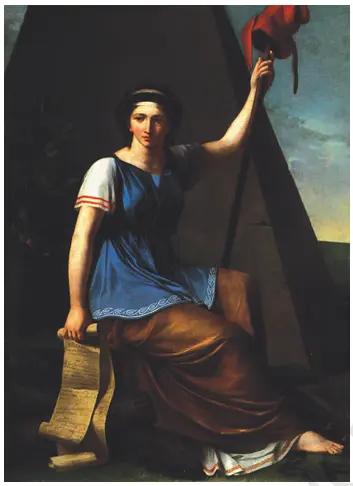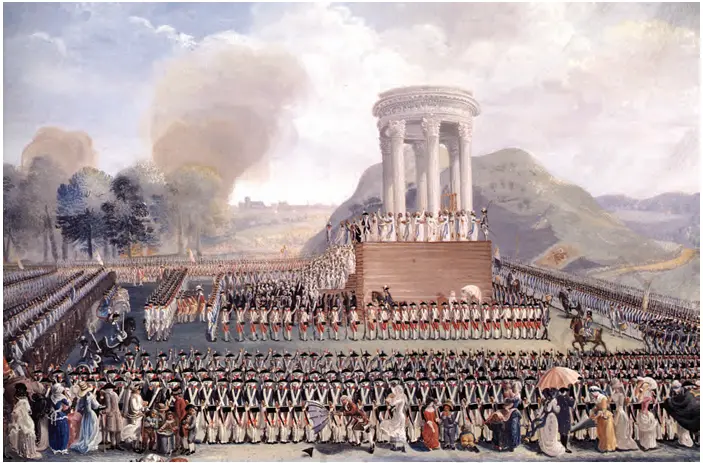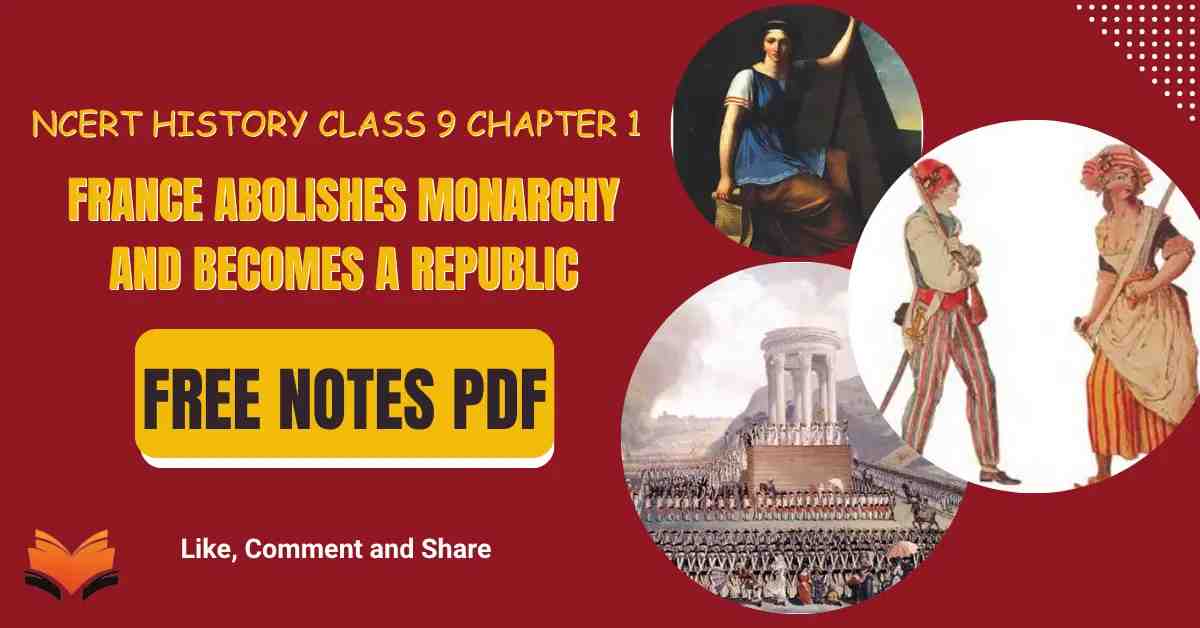France Abolishes Monarchy And Becomes A Republic – Concept & Notes PDF
Topic & sub-topics covered: France Abolishes Monarchy And Becomes A Republic and MCQs Questions: The French Revolution (All single detail notes are exam-oriented).
We have discussed in-depth and exam-oriented pointers that can be asked in the board exam of class 9th about the “The Outbreak of the Revolution” from the NCERT History notes for class 9th chapter 1st “The French Revolution“.
Download the NCERT History for Class 9th Chapter 1 The French Revolution Notes PDF
NCERT History for Class 9th Chapter 1_ The French Revolution Notes & MCQ’s Question-Answer
Hey Class 9! The French Revolution chapter topic “France Abolishes Monarchy And Becomes A Republic” giving you a headache? Yeah, been there. So many names, dates, and those confusing terms like Estates General and Reign of Terror – it’s a lot, right?
When I first read this chapter, I honestly had no clue what was going on. Like… why were people storming a prison? Who even was Louis XVI? But once someone explained it in simple language, it finally clicked. That’s exactly why I made these notes – to help you get it without drowning in textbook blah-blah.
These notes are short, straight to the point, and written like a friend explaining stuff – not some robotic lecture. Whether you’re cramming before an exam (we’ve all done it) or just revising bit by bit, this France Abolishes Monarchy And Becomes A Republic notes class 9 pdf got your back. And yep, it works offline too – because let’s face it, your Wi-Fi bails right when you need it most. Oh, and guess what? You can download it right below. Go on, grab it. No stress.
France Abolishes Monarchy and Becomes a Republic

1. Tensions after the Constitution of 1791:
- Even after signing the Constitution, Louis XVI entered into secret negotiations with the King of Prussia.
- Neighbouring monarchies feared the spread of revolutionary ideas and planned military intervention in France.
2. War Against Monarchies:
- In April 1792, the National Assembly declared war against Prussia and Austria.
- Thousands of volunteers joined the army, viewing it as a people’s war against kings and aristocracy across Europe.
3. The Marseillaise: Patriotic Anthem:
- Roget de L’Isle, a poet, composed ‘La Marseillaise’, a patriotic war song.
- It was first sung by volunteers from Marseilles as they marched into Paris.
- Today, La Marseillaise is the national anthem of France.
4. Impact of Revolutionary Wars on Common People:
- The wars caused economic difficulties and losses.
- While men fought, women managed households and worked for survival.
- Many felt that the revolution must go further, as the Constitution of 1791 only benefited the rich.
5. Rise of Political Clubs:
- Political clubs became centers for debate and action planning.
- The most influential club was the Jacobins, named after the convent of St Jacob in Paris.
- Even women formed their own clubs to voice demands and concerns.
6. Who Were the Jacobins?:
- Jacobins came from lower-income groups like small shopkeepers, artisans, and daily wage workers.
- Their leader was Maximilian Robespierre.
- Jacobins rejected the fashion of the aristocracy and wore long striped trousers instead of knee breeches.
- This dress code marked them as sans-culottes, meaning ‘those without knee breeches’.
- Sans-culottes also wore a red cap, symbolizing liberty, but women were not allowed to wear it.

7. Storming of the Palace and End of Monarchy:
- In August 1792, the Jacobins led an insurrection due to shortages and high food prices.
- On 10 August, they stormed the Palace of the Tuileries, killed the king’s guards, and held the king hostage.
- As a result, the royal family was imprisoned.
8. Universal Male Suffrage:
- New elections were held where all men aged 21+ could vote, regardless of wealth or class.
- This marked the beginning of universal male suffrage in revolutionary France.
9. France Becomes a Republic:
- The new elected assembly was named the Convention.
- On 21 September 1792, it abolished the monarchy and declared France a republic.
- A republic is a system where leaders are elected and no hereditary monarchy exists.
10. Execution of Louis XVI and Marie Antoinette:
- Louis XVI was convicted of treason and executed publicly on 21 January 1793 at the Place de la Concorde.
- Queen Marie Antoinette was also executed shortly after.
The Reign of Terror

1. Definition and Timeframe:
- The period from 1793 to 1794 is known as the Reign of Terror.
- It was led by Maximilian Robespierre, the leader of the Jacobins.
2. Robespierre’s Harsh Policies:
- Robespierre believed in strict control and punishment to safeguard the republic.
- He targeted anyone considered an ‘enemy of the republic’, including:
a. Ex-nobles and clergy
b. Rival political party members
c. Even his own supporters who disagreed with him
3. Use of Revolutionary Tribunal and Guillotine:
- Suspected enemies were arrested, tried by a revolutionary tribunal, and if found guilty, guillotined.
- The guillotine was a beheading device with a blade, named after its inventor Dr. Guillotin.
4. Economic Control Measures:
- Robespierre’s government:
a. Fixed a maximum ceiling on wages and prices.
b. Introduced rationing of meat and bread.
c. Forced peasants to bring grain to cities and sell it at government-fixed prices. - The use of white flour was banned.
- Everyone had to eat pain d’égalité (equality bread) made from wholewheat.
5. Social Reforms and Symbols of Equality:
- Traditional terms like Monsieur (Sir) and Madame (Madam) were replaced with Citoyen and Citoyenne (Citizen).
- This linguistic change was meant to promote equality and citizenship.
- Churches were closed, and many were converted into offices or barracks to reduce religious influence.
6. Fall of Robespierre:
- Robespierre’s policies became so extreme that even his allies turned against him.
- In July 1794, Robespierre was:
a. Convicted by a court
b. Arrested
c. Executed the next day by the guillotine
Source D
1. Viewpoint of Camille Desmoulins:
- Camille Desmoulins, a revolutionary journalist, criticized Robespierre’s use of terror.
- He believed liberty is not achieved through terror but through happiness, reason, equality, and justice.
- He warned that guillotining one enemy creates ten more.
- He was executed during the Reign of Terror, showing Robespierre’s intolerance of criticism.
2. Robespierre’s Justification for Terror:
- On 7 February 1794, Robespierre declared in the Convention:
a. Terror was necessary to defend liberty.
b. Terror is “swift, severe, inflexible justice” in times of revolution. - He believed terror was essential to destroy domestic and foreign enemies and to establish democracy.
A Directory Rules France
1. Aftermath of the Jacobin Government:
- The fall of the Jacobins led to the wealthy middle class taking control of power.
- A new constitution was introduced after the Jacobins lost power.
2. Features of the New Constitution:
- The new constitution denied voting rights to the non-propertied sections of society (only property-owning men could vote).
- It created two elected legislative councils to make laws.
3. Creation of the Directory:
- The two councils elected an executive body called the Directory.
- The Directory was made up of five members.
- This system was designed to prevent the concentration of power in the hands of one person (unlike Robespierre’s rule).
4. Political Instability of the Directory:
- There were frequent clashes between the Directory and the legislative councils.
- The legislative councils often tried to dismiss the Directors, leading to political instability.
5. Rise of Napoleon Bonaparte:
- The continued instability under the Directory created conditions for a military dictator to rise.
- Eventually, Napoleon Bonaparte seized power, ending the Directory rule.
6. Lasting Ideals of the French Revolution:
- Despite changes in government, the ideals of the Revolution – liberty, equality before the law, and fraternity – remained strong.
- These revolutionary ideas inspired political movements in France and across Europe throughout the 19th century.
New words:
Convent – Building belonging to a community devoted to a religious life.
Next & Previous Topics of NCERT/CBSE History Class 9 Chapter 1: The French Revolution
MCQs on NCERT History Class 9 Chapter 1 Topic – France Abolishes Monarchy and Becomes a Republic
Here are the top exam-oriented MCQ-type questions on “France Abolishes Monarchy and Becomes a Republic” that you should prepare for your CBSE or state board exams:
Question 1. Who composed the song ‘Marseillaise’?
a) Maximilian Robespierre
b) Georges Danton
c) Jean Jacques Rousseau
d) Roget de L’Isle
Answer: d) Roget de L’Isle
Question 2. Why did the National Assembly declare war on Prussia and Austria in April 1792?
a) To spread monarchy
b) To suppress revolution
c) To defend France from foreign threats
d) To support Britain
Answer: c) To defend France from foreign threats
Question 3. What is the national anthem of France?
a) The Spirit of the Laws
b) Marseillaise
c) Liberty March
d) La Révolution
Answer: b) Marseillaise
Question 4. Who led the Jacobin Club?
a) Georges Danton
b) Napoleon Bonaparte
c) Camille Desmoulins
d) Maximilian Robespierre
Answer: d) Maximilian Robespierre
Question 5. What was the symbolic dress of the Jacobins called?
a) Breeches
b) Sans-culottes
c) Trousers of Liberty
d) Red Caps
Answer: b) Sans-culottes
Question 6. What does ‘Sans-culottes’ literally mean?
a) Those with red caps
b) Those without coats
c) Those without knee breeches
d) Those with liberty
Answer: c) Those without knee breeches
Question 7. When was monarchy abolished and France declared a republic?
a) 10 August 1792
b) 14 July 1789
c) 21 September 1792
d) 5 May 1789
Answer: c) 21 September 1792
Question 8. Why was Louis XVI executed?
a) For corruption
b) For trying to escape
c) On the charge of treason
d) For supporting the Jacobins
Answer: c) On the charge of treason
Question 9. What device was used for executions during the Reign of Terror?
a) Firing squad
b) Guillotine
c) Rope
d) Sword
Answer: b) Guillotine
Question 10. What was the period from 1793 to 1794 known as?
a) Age of Reason
b) Enlightenment Period
c) Reign of Terror
d) Jacobin Rule
Answer: c) Reign of Terror
Question 11. Which of the following was not a law introduced by Robespierre’s government?
a) Rationing of bread
b) Ceiling on wages
c) Encouragement of luxury goods
d) Use of wholewheat bread
Answer: c) Encouragement of luxury goods
Question 12. What were French citizens required to eat during the Reign of Terror?
a) Baguettes
b) White bread
c) Pain d’égalité (equality bread)
d) Rice and beans
Answer: c) Pain d’égalité (equality bread)
Question 13. What were citizens called during Robespierre’s rule?
a) Monsieur and Madame
b) Sire and Lady
c) Citoyen and Citoyenne
d) Comrade
Answer: c) Citoyen and Citoyenne
Question 14. Why was Robespierre eventually executed?
a) He supported monarchy
b) He was a traitor
c) He imposed extreme policies and lost support
d) He was anti-revolution
Answer: c) He imposed extreme policies and lost support
Question 15. What system of government was set up after the fall of Jacobins?
a) Monarchy
b) Republic under Napoleon
c) Directory
d) Military dictatorship
Answer: c) Directory
Question 16. How many members were there in the Directory?
a) Three
b) Four
c) Five
d) Six
Answer: c) Five
Question 17. What was the major problem with the Directory system?
a) It supported monarchy
b) It was too democratic
c) Constant conflict with legislative councils
d) It gave voting rights to all
Answer: c) Constant conflict with legislative councils
Question 18. The political instability of the Directory led to the rise of:
a) Robespierre
b) Rousseau
c) Napoleon Bonaparte
d) Louis XVII
Answer: c) Napoleon Bonaparte
Question 19. The ideals that continued to inspire political movements in Europe were:
a) Socialism and Capitalism
b) Liberty, Equality, Fraternity
c) Monarchy and Feudalism
d) Democracy and Federalism
Answer: b) Liberty, Equality, Fraternity
Reason Type MCQs on NCERT History Class 9 Chapter 1 Topic – France Abolishes Monarchy and Becomes a Republic
Question 1.
Assertion (A): Louis XVI was sentenced to death by a court in 1793.
Reason (R): He was found guilty of treason and conspiring with foreign monarchs.
a) Both A and R are true, and R is the correct explanation of A.
b) Both A and R are true, but R is not the correct explanation of A.
c) A is true, but R is false.
d) A is false, but R is true.
Answer: a) Both A and R are true, and R is the correct explanation of A.
Question 2.
Assertion (A): The Reign of Terror was marked by excessive control and punishment.
Reason (R): Robespierre allowed complete press freedom and opposed the use of the guillotine.
a) Both A and R are true, and R is the correct explanation of A.
b) Both A and R are true, but R is not the correct explanation of A.
c) A is true, but R is false.
d) A is false, but R is true.
Answer: c) A is true, but R is false.
Question 3.
Assertion (A): The Jacobin Club was formed by the nobility and upper clergy of French society.
Reason (R): They wanted to preserve the feudal privileges and restore monarchy.
a) Both A and R are true, and R is the correct explanation of A.
b) Both A and R are true, but R is not the correct explanation of A.
c) A is true, but R is false.
d) Both A and R are false.
Answer: d) Both A and R are false.
Question 4.
Assertion (A): The term sans-culottes was used for Jacobins who wore long striped trousers.
Reason (R): They used this attire to show solidarity with workers and to oppose aristocratic fashion.
a) Both A and R are true, and R is the correct explanation of A.
b) Both A and R are true, but R is not the correct explanation of A.
c) A is true, but R is false.
d) A is false, but R is true.
Answer: a) Both A and R are true, and R is the correct explanation of A.
Question 5.
Assertion (A): Women played a central role in the Jacobin club and led major revolts.
Reason (R): Women were allowed to wear red liberty caps and participate equally in the political process.
a) Both A and R are true, and R is the correct explanation of A.
b) Both A and R are true, but R is not the correct explanation of A.
c) A is true, but R is false.
d) A is false, but R is true.
Answer: c) A is true, but R is false.
Question 6.
Assertion (A): The Reign of Terror ended with the execution of Robespierre in 1794.
Reason (R): People had grown tired of his harsh policies and demanded moderation.
a) Both A and R are true, and R is the correct explanation of A.
b) Both A and R are true, but R is not the correct explanation of A.
c) A is true, but R is false.
d) A is false, but R is true.
Answer: a) Both A and R are true, and R is the correct explanation of A.
Question 7.
Assertion (A): The Directory failed to bring political stability in France.
Reason (R): The Constitution gave voting rights to all adult citizens regardless of property.
a) Both A and R are true, and R is the correct explanation of A.
b) Both A and R are true, but R is not the correct explanation of A.
c) A is true, but R is false.
d) A is false, but R is true.
Answer: c) A is true, but R is false.

